Fannie Mae Risk Assessment and Stakeholder Analysis Report
VerifiedAdded on 2023/06/03
|37
|5045
|433
Report
AI Summary
This report provides a comprehensive analysis of Fannie Mae's risk management practices, focusing on its role in the American mortgage market. It begins with an overview of the company, including its business operations, share price performance, and competitive environment. The report then delves into the identification of key stakeholders, categorizing them as internal and external, and assessing their influence and interests. A significant portion of the report is dedicated to a detailed risk assessment, outlining a risk model with twenty identified risks, along with a diagram of the top ten risks and a radar diagram. The risks include changes in government legislation, economic weakening, and data theft, among others. For each risk, the report evaluates its potential impact on the business and proposes possible mitigation actions. The report concludes with an assessment of the company's risk culture and provides recommendations for investors, suggesting a long-term investment strategy. The analysis utilizes various financial data, graphs, and tables to support the findings.
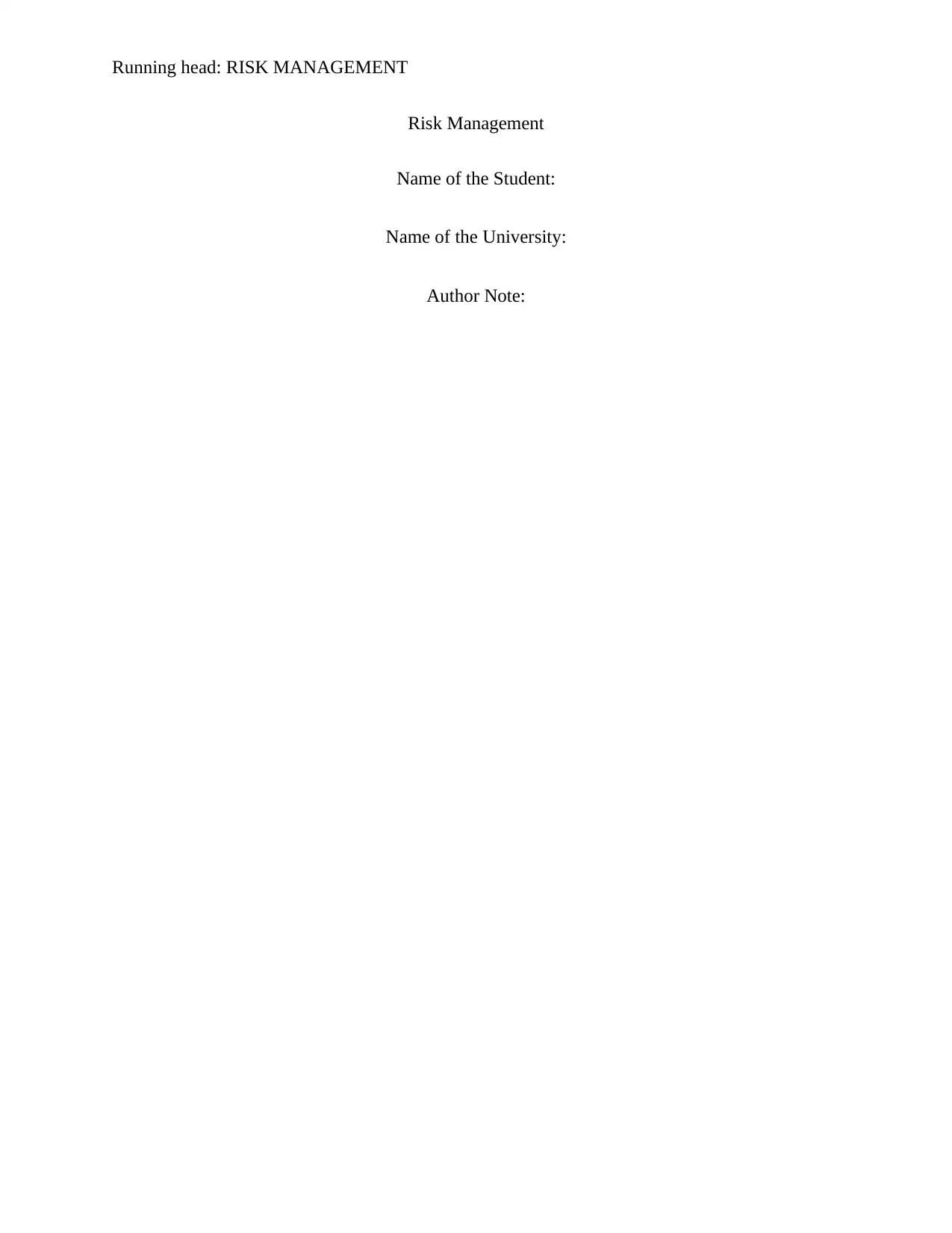
Running head: RISK MANAGEMENT
Risk Management
Name of the Student:
Name of the University:
Author Note:
Risk Management
Name of the Student:
Name of the University:
Author Note:
Paraphrase This Document
Need a fresh take? Get an instant paraphrase of this document with our AI Paraphraser
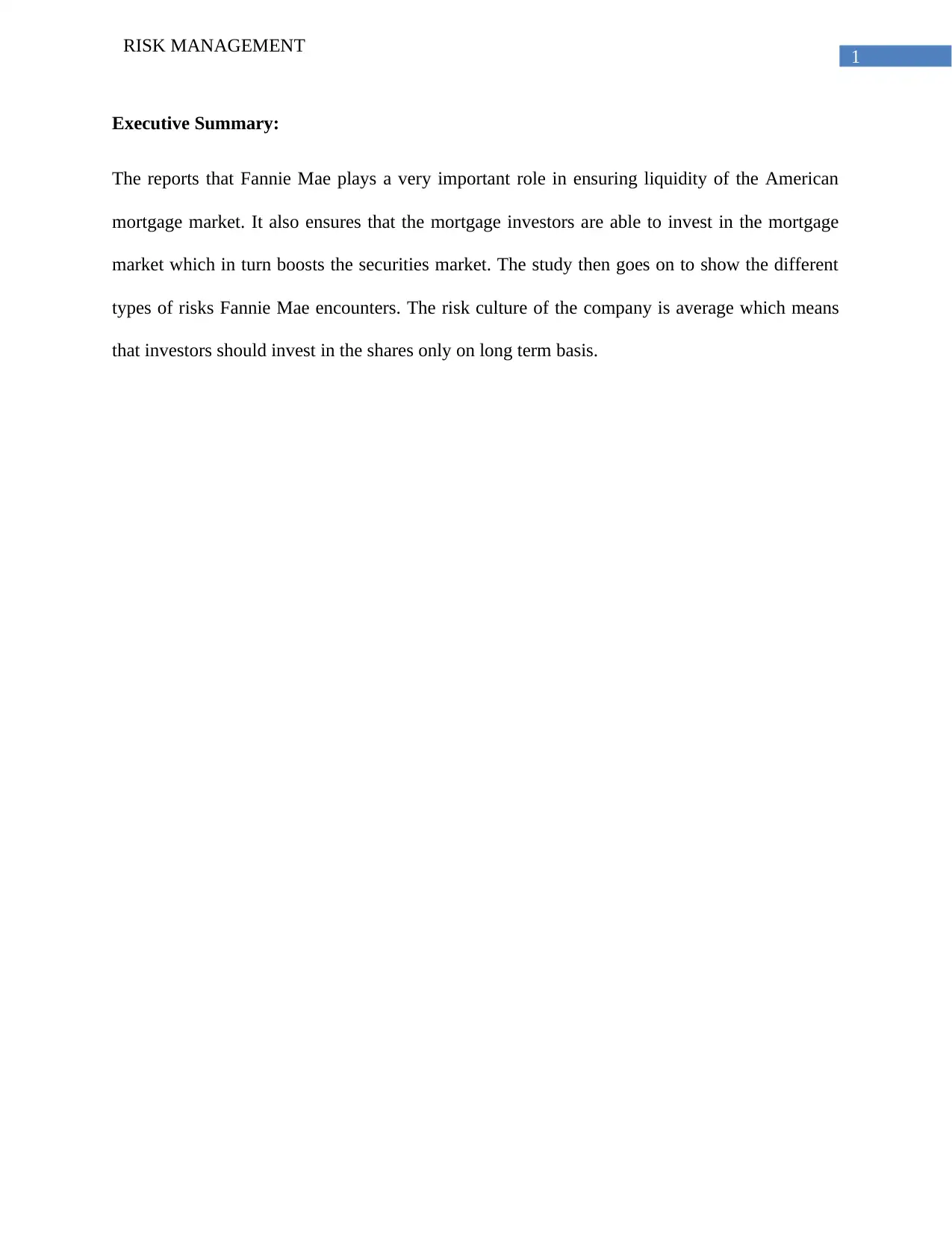
1
RISK MANAGEMENT
Executive Summary:
The reports that Fannie Mae plays a very important role in ensuring liquidity of the American
mortgage market. It also ensures that the mortgage investors are able to invest in the mortgage
market which in turn boosts the securities market. The study then goes on to show the different
types of risks Fannie Mae encounters. The risk culture of the company is average which means
that investors should invest in the shares only on long term basis.
RISK MANAGEMENT
Executive Summary:
The reports that Fannie Mae plays a very important role in ensuring liquidity of the American
mortgage market. It also ensures that the mortgage investors are able to invest in the mortgage
market which in turn boosts the securities market. The study then goes on to show the different
types of risks Fannie Mae encounters. The risk culture of the company is average which means
that investors should invest in the shares only on long term basis.
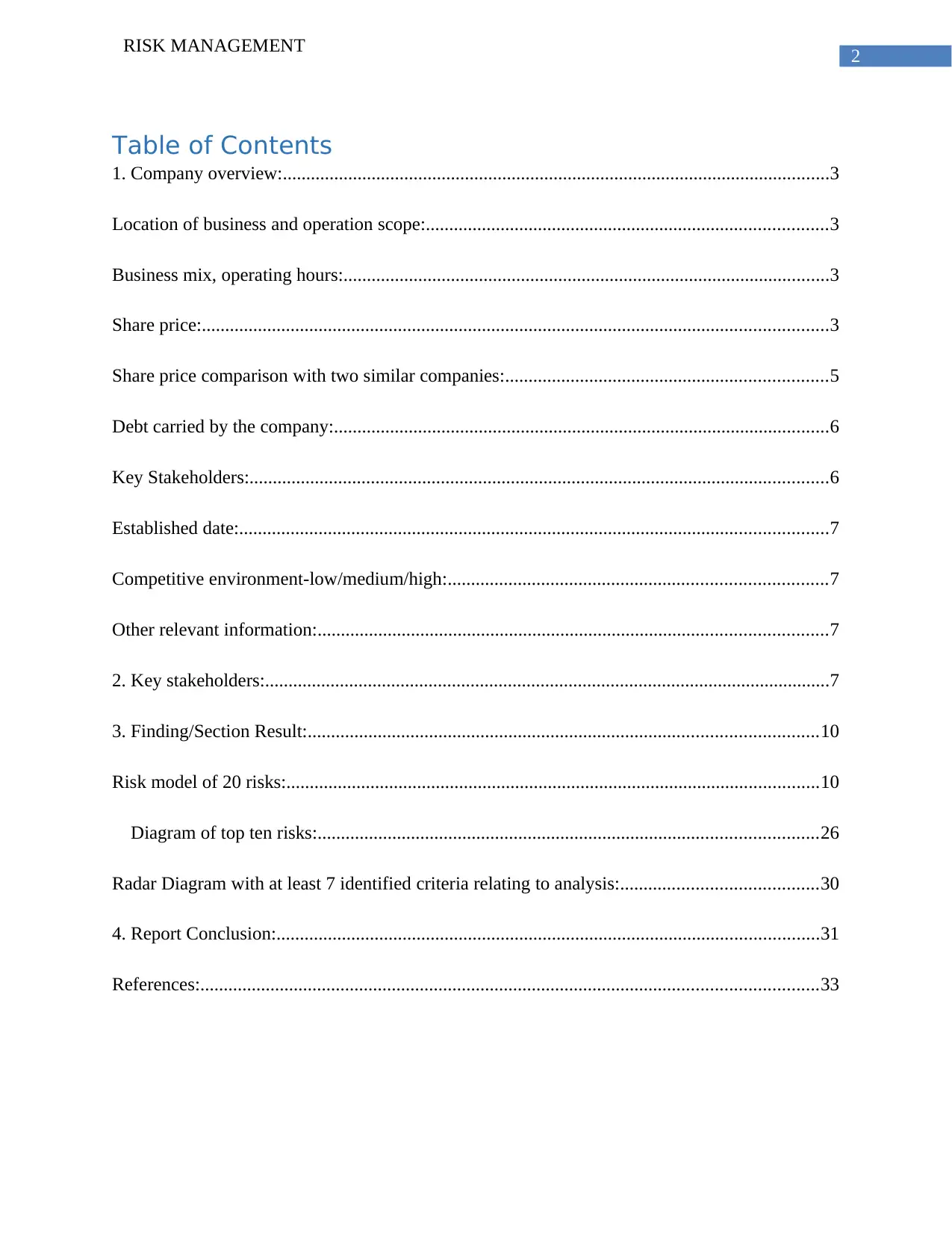
2
RISK MANAGEMENT
Table of Contents
1. Company overview:.....................................................................................................................3
Location of business and operation scope:......................................................................................3
Business mix, operating hours:........................................................................................................3
Share price:......................................................................................................................................3
Share price comparison with two similar companies:.....................................................................5
Debt carried by the company:..........................................................................................................6
Key Stakeholders:............................................................................................................................6
Established date:..............................................................................................................................7
Competitive environment-low/medium/high:.................................................................................7
Other relevant information:.............................................................................................................7
2. Key stakeholders:.........................................................................................................................7
3. Finding/Section Result:.............................................................................................................10
Risk model of 20 risks:..................................................................................................................10
Diagram of top ten risks:...........................................................................................................26
Radar Diagram with at least 7 identified criteria relating to analysis:..........................................30
4. Report Conclusion:....................................................................................................................31
References:....................................................................................................................................33
RISK MANAGEMENT
Table of Contents
1. Company overview:.....................................................................................................................3
Location of business and operation scope:......................................................................................3
Business mix, operating hours:........................................................................................................3
Share price:......................................................................................................................................3
Share price comparison with two similar companies:.....................................................................5
Debt carried by the company:..........................................................................................................6
Key Stakeholders:............................................................................................................................6
Established date:..............................................................................................................................7
Competitive environment-low/medium/high:.................................................................................7
Other relevant information:.............................................................................................................7
2. Key stakeholders:.........................................................................................................................7
3. Finding/Section Result:.............................................................................................................10
Risk model of 20 risks:..................................................................................................................10
Diagram of top ten risks:...........................................................................................................26
Radar Diagram with at least 7 identified criteria relating to analysis:..........................................30
4. Report Conclusion:....................................................................................................................31
References:....................................................................................................................................33
⊘ This is a preview!⊘
Do you want full access?
Subscribe today to unlock all pages.

Trusted by 1+ million students worldwide
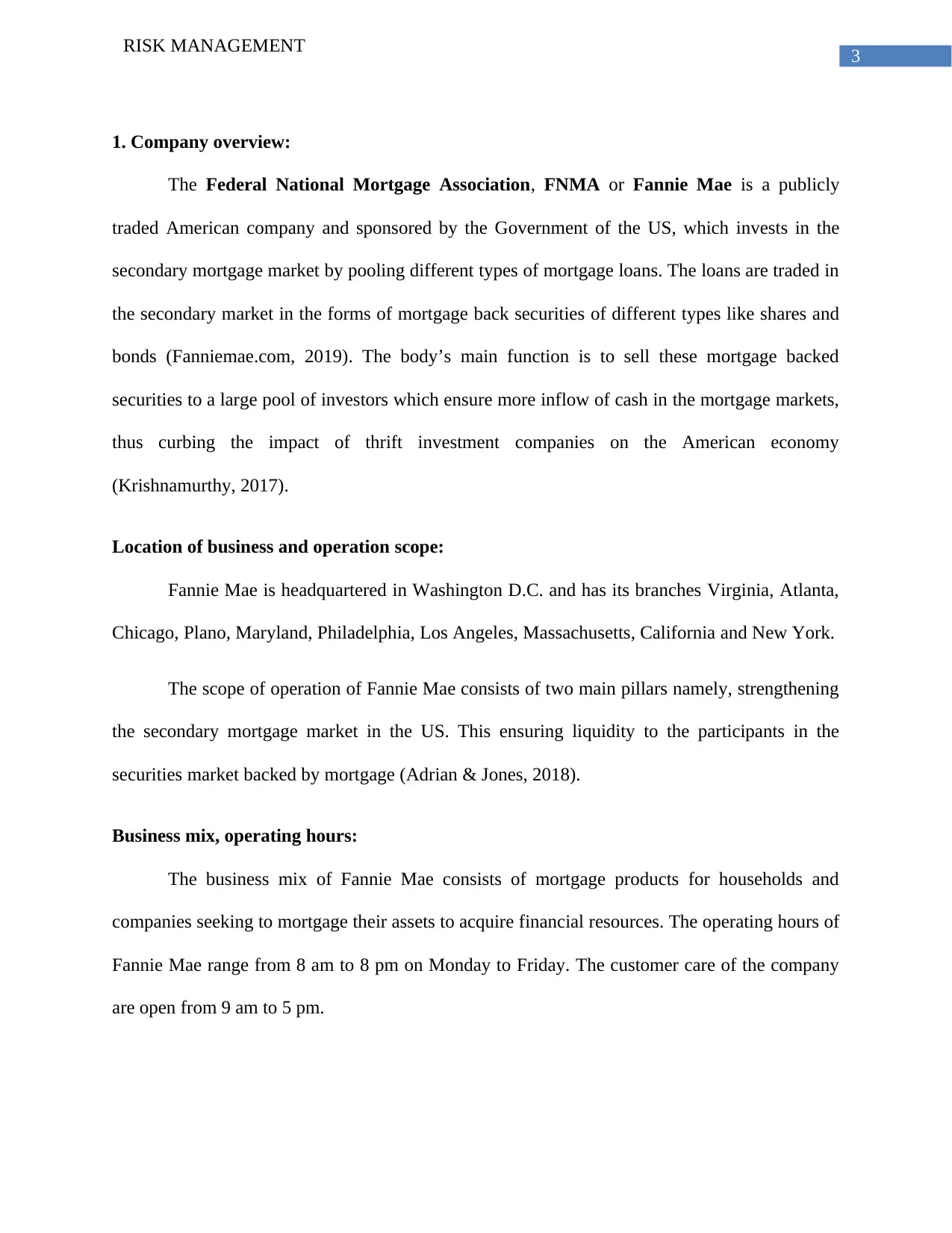
3
RISK MANAGEMENT
1. Company overview:
The Federal National Mortgage Association, FNMA or Fannie Mae is a publicly
traded American company and sponsored by the Government of the US, which invests in the
secondary mortgage market by pooling different types of mortgage loans. The loans are traded in
the secondary market in the forms of mortgage back securities of different types like shares and
bonds (Fanniemae.com, 2019). The body’s main function is to sell these mortgage backed
securities to a large pool of investors which ensure more inflow of cash in the mortgage markets,
thus curbing the impact of thrift investment companies on the American economy
(Krishnamurthy, 2017).
Location of business and operation scope:
Fannie Mae is headquartered in Washington D.C. and has its branches Virginia, Atlanta,
Chicago, Plano, Maryland, Philadelphia, Los Angeles, Massachusetts, California and New York.
The scope of operation of Fannie Mae consists of two main pillars namely, strengthening
the secondary mortgage market in the US. This ensuring liquidity to the participants in the
securities market backed by mortgage (Adrian & Jones, 2018).
Business mix, operating hours:
The business mix of Fannie Mae consists of mortgage products for households and
companies seeking to mortgage their assets to acquire financial resources. The operating hours of
Fannie Mae range from 8 am to 8 pm on Monday to Friday. The customer care of the company
are open from 9 am to 5 pm.
RISK MANAGEMENT
1. Company overview:
The Federal National Mortgage Association, FNMA or Fannie Mae is a publicly
traded American company and sponsored by the Government of the US, which invests in the
secondary mortgage market by pooling different types of mortgage loans. The loans are traded in
the secondary market in the forms of mortgage back securities of different types like shares and
bonds (Fanniemae.com, 2019). The body’s main function is to sell these mortgage backed
securities to a large pool of investors which ensure more inflow of cash in the mortgage markets,
thus curbing the impact of thrift investment companies on the American economy
(Krishnamurthy, 2017).
Location of business and operation scope:
Fannie Mae is headquartered in Washington D.C. and has its branches Virginia, Atlanta,
Chicago, Plano, Maryland, Philadelphia, Los Angeles, Massachusetts, California and New York.
The scope of operation of Fannie Mae consists of two main pillars namely, strengthening
the secondary mortgage market in the US. This ensuring liquidity to the participants in the
securities market backed by mortgage (Adrian & Jones, 2018).
Business mix, operating hours:
The business mix of Fannie Mae consists of mortgage products for households and
companies seeking to mortgage their assets to acquire financial resources. The operating hours of
Fannie Mae range from 8 am to 8 pm on Monday to Friday. The customer care of the company
are open from 9 am to 5 pm.
Paraphrase This Document
Need a fresh take? Get an instant paraphrase of this document with our AI Paraphraser
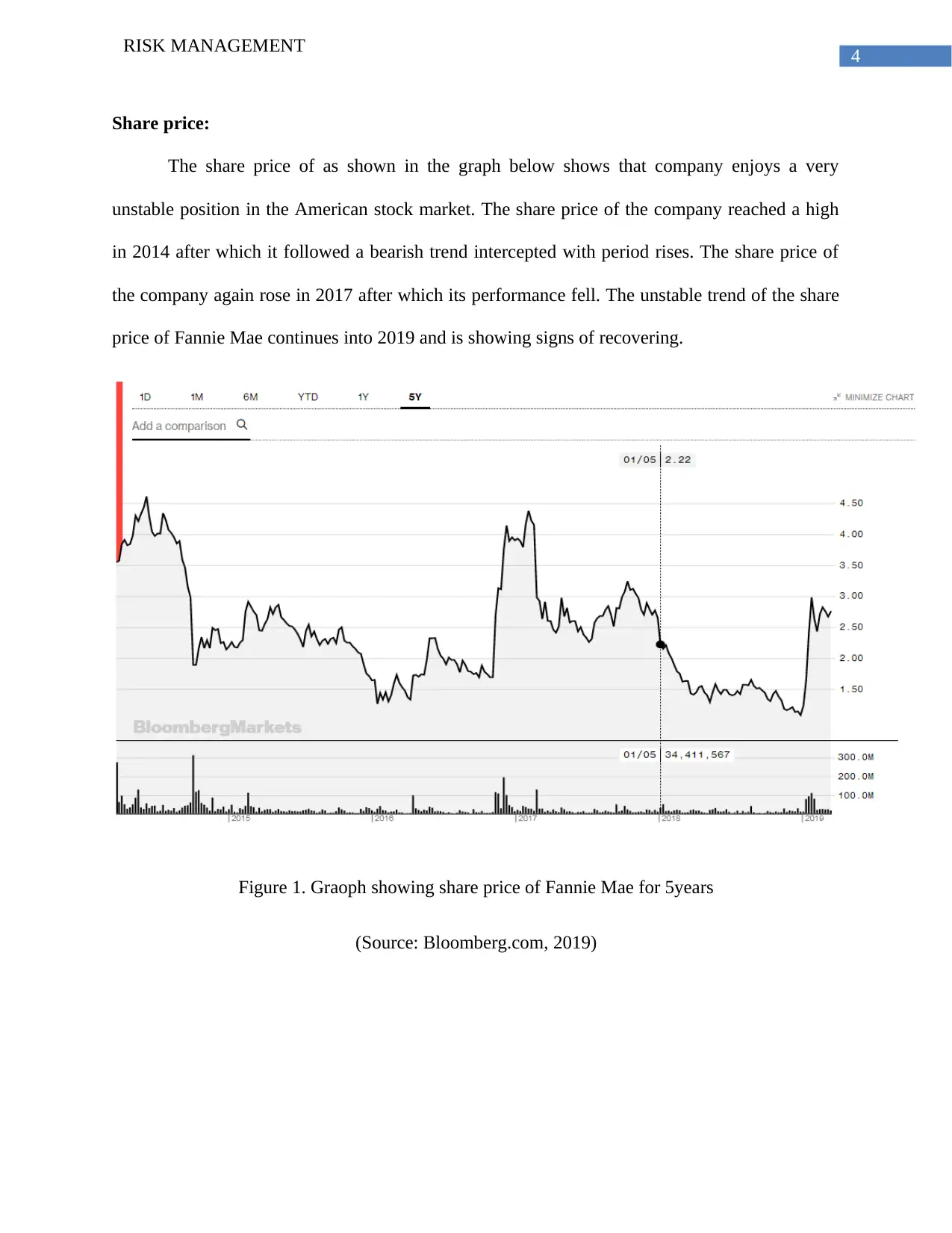
4
RISK MANAGEMENT
Share price:
The share price of as shown in the graph below shows that company enjoys a very
unstable position in the American stock market. The share price of the company reached a high
in 2014 after which it followed a bearish trend intercepted with period rises. The share price of
the company again rose in 2017 after which its performance fell. The unstable trend of the share
price of Fannie Mae continues into 2019 and is showing signs of recovering.
Figure 1. Graoph showing share price of Fannie Mae for 5years
(Source: Bloomberg.com, 2019)
RISK MANAGEMENT
Share price:
The share price of as shown in the graph below shows that company enjoys a very
unstable position in the American stock market. The share price of the company reached a high
in 2014 after which it followed a bearish trend intercepted with period rises. The share price of
the company again rose in 2017 after which its performance fell. The unstable trend of the share
price of Fannie Mae continues into 2019 and is showing signs of recovering.
Figure 1. Graoph showing share price of Fannie Mae for 5years
(Source: Bloomberg.com, 2019)
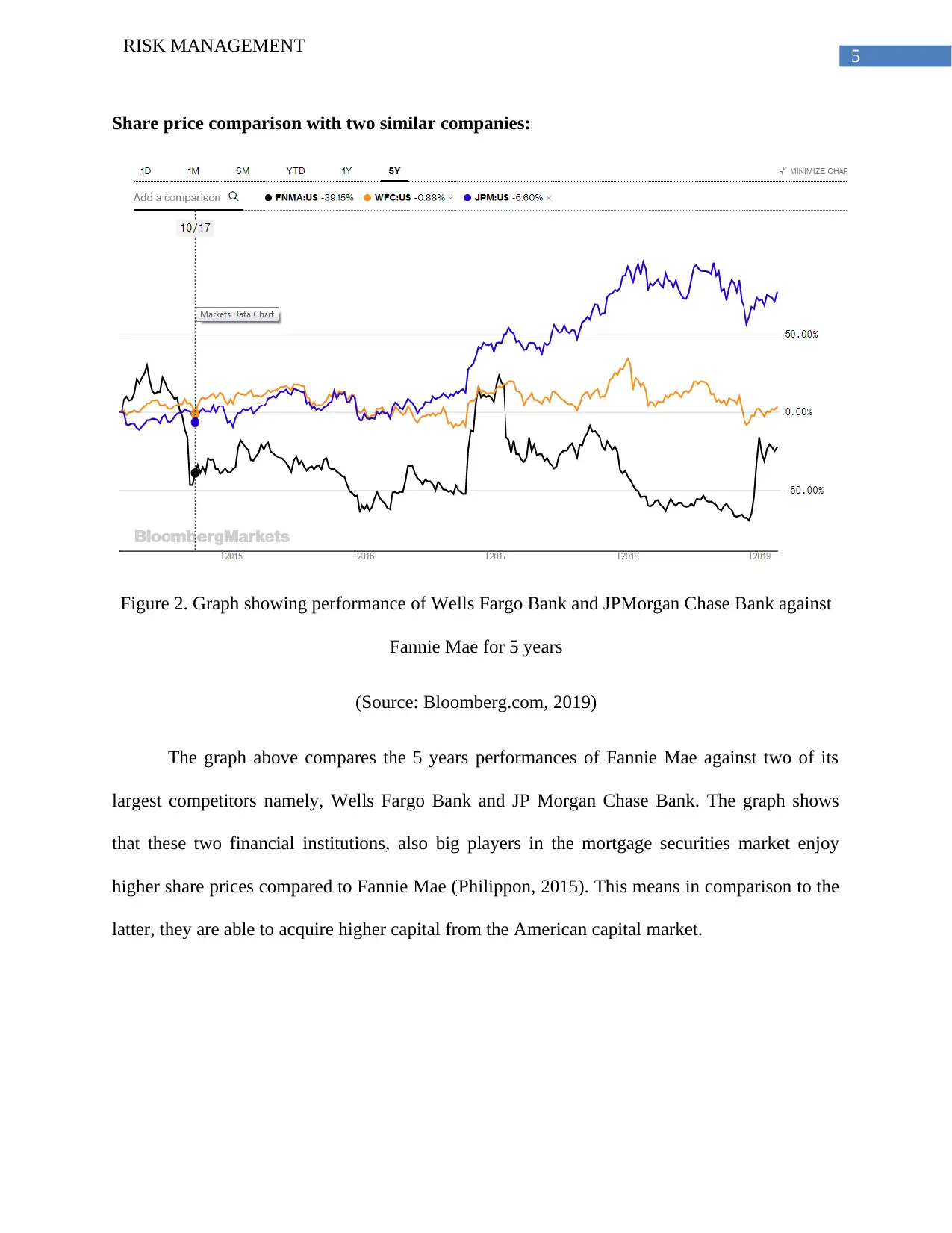
5
RISK MANAGEMENT
Share price comparison with two similar companies:
Figure 2. Graph showing performance of Wells Fargo Bank and JPMorgan Chase Bank against
Fannie Mae for 5 years
(Source: Bloomberg.com, 2019)
The graph above compares the 5 years performances of Fannie Mae against two of its
largest competitors namely, Wells Fargo Bank and JP Morgan Chase Bank. The graph shows
that these two financial institutions, also big players in the mortgage securities market enjoy
higher share prices compared to Fannie Mae (Philippon, 2015). This means in comparison to the
latter, they are able to acquire higher capital from the American capital market.
RISK MANAGEMENT
Share price comparison with two similar companies:
Figure 2. Graph showing performance of Wells Fargo Bank and JPMorgan Chase Bank against
Fannie Mae for 5 years
(Source: Bloomberg.com, 2019)
The graph above compares the 5 years performances of Fannie Mae against two of its
largest competitors namely, Wells Fargo Bank and JP Morgan Chase Bank. The graph shows
that these two financial institutions, also big players in the mortgage securities market enjoy
higher share prices compared to Fannie Mae (Philippon, 2015). This means in comparison to the
latter, they are able to acquire higher capital from the American capital market.
⊘ This is a preview!⊘
Do you want full access?
Subscribe today to unlock all pages.

Trusted by 1+ million students worldwide
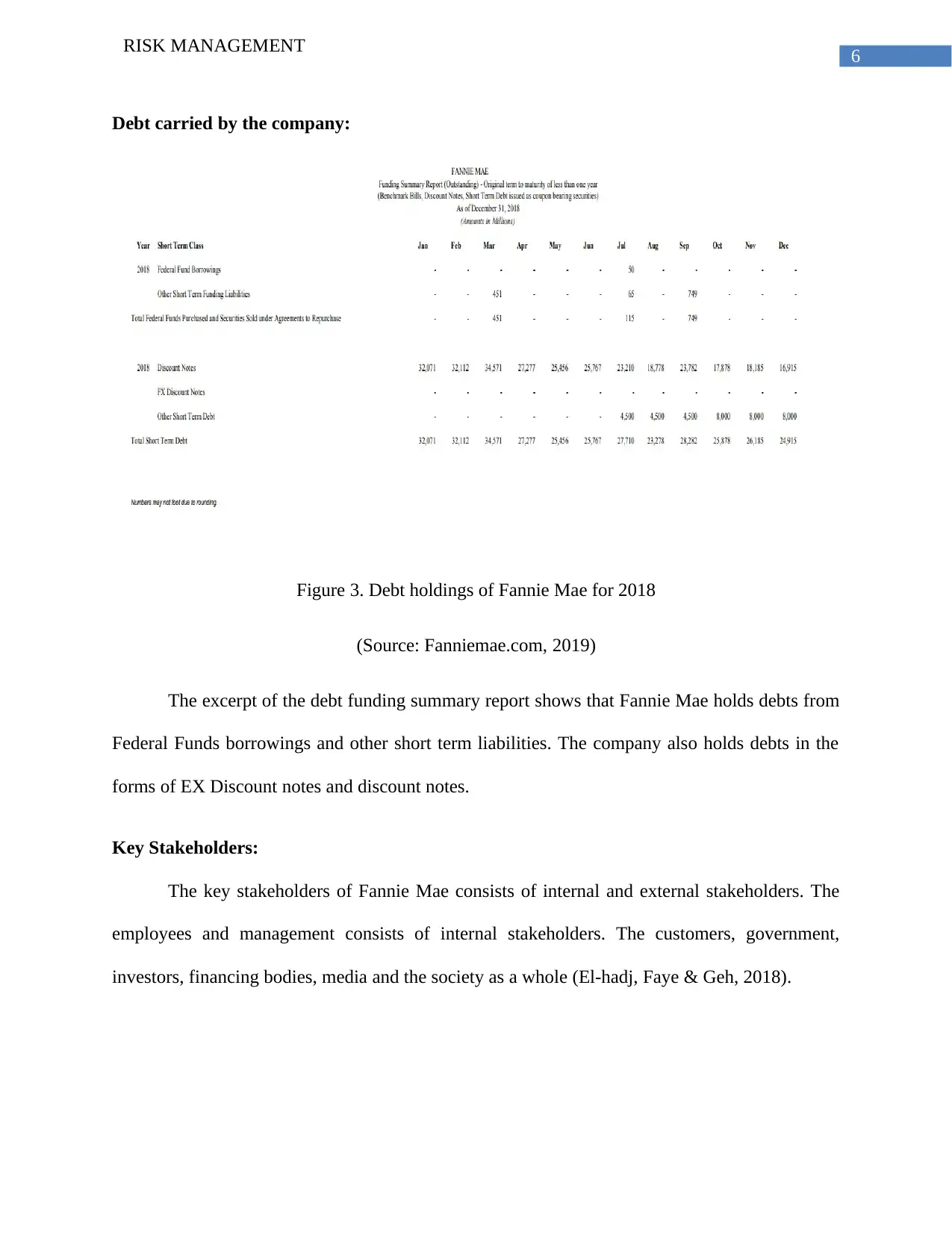
6
RISK MANAGEMENT
Debt carried by the company:
Figure 3. Debt holdings of Fannie Mae for 2018
(Source: Fanniemae.com, 2019)
The excerpt of the debt funding summary report shows that Fannie Mae holds debts from
Federal Funds borrowings and other short term liabilities. The company also holds debts in the
forms of EX Discount notes and discount notes.
Key Stakeholders:
The key stakeholders of Fannie Mae consists of internal and external stakeholders. The
employees and management consists of internal stakeholders. The customers, government,
investors, financing bodies, media and the society as a whole (El-hadj, Faye & Geh, 2018).
RISK MANAGEMENT
Debt carried by the company:
Figure 3. Debt holdings of Fannie Mae for 2018
(Source: Fanniemae.com, 2019)
The excerpt of the debt funding summary report shows that Fannie Mae holds debts from
Federal Funds borrowings and other short term liabilities. The company also holds debts in the
forms of EX Discount notes and discount notes.
Key Stakeholders:
The key stakeholders of Fannie Mae consists of internal and external stakeholders. The
employees and management consists of internal stakeholders. The customers, government,
investors, financing bodies, media and the society as a whole (El-hadj, Faye & Geh, 2018).
Paraphrase This Document
Need a fresh take? Get an instant paraphrase of this document with our AI Paraphraser
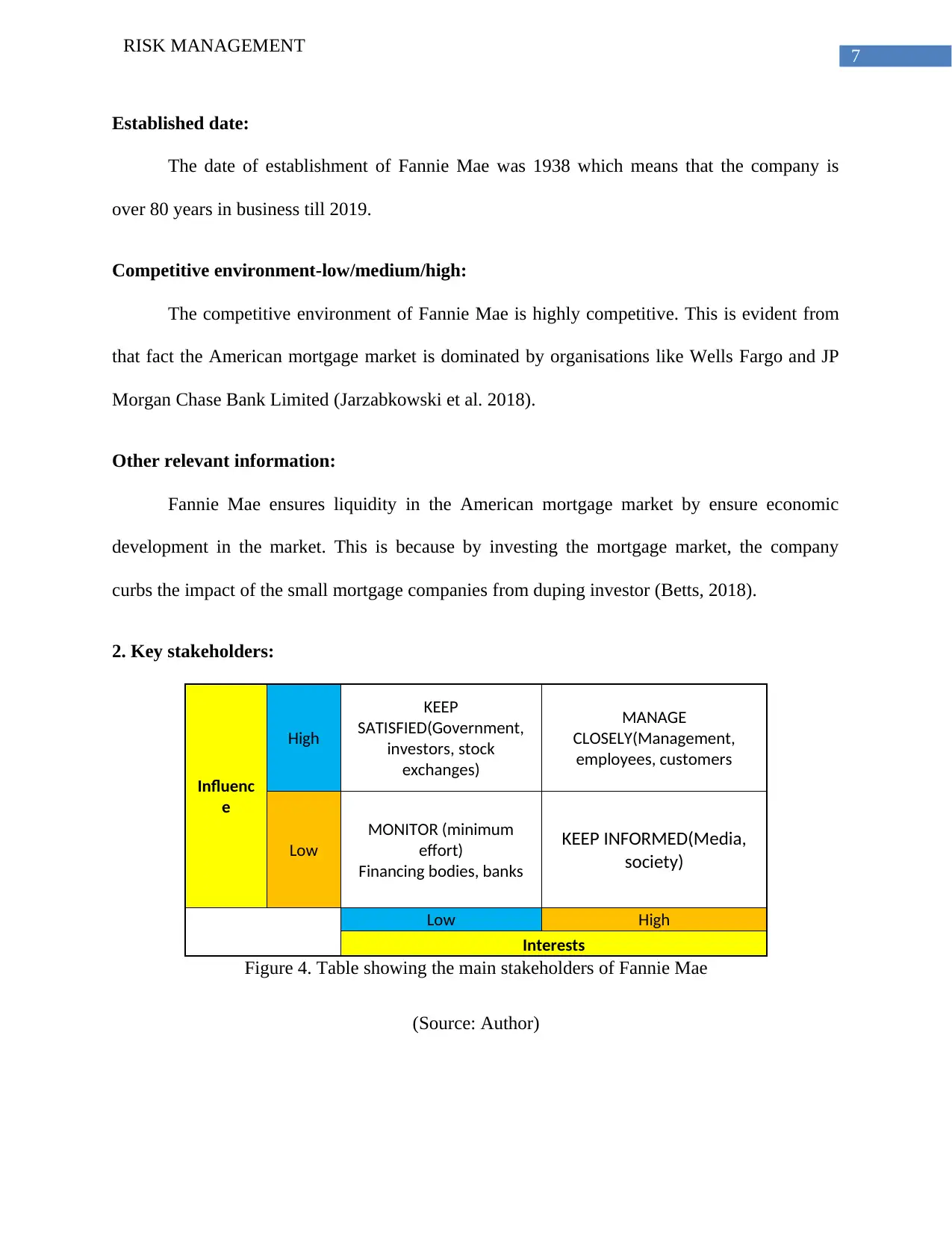
7
RISK MANAGEMENT
Established date:
The date of establishment of Fannie Mae was 1938 which means that the company is
over 80 years in business till 2019.
Competitive environment-low/medium/high:
The competitive environment of Fannie Mae is highly competitive. This is evident from
that fact the American mortgage market is dominated by organisations like Wells Fargo and JP
Morgan Chase Bank Limited (Jarzabkowski et al. 2018).
Other relevant information:
Fannie Mae ensures liquidity in the American mortgage market by ensure economic
development in the market. This is because by investing the mortgage market, the company
curbs the impact of the small mortgage companies from duping investor (Betts, 2018).
2. Key stakeholders:
Influenc
e
High
KEEP
SATISFIED(Government,
investors, stock
exchanges)
MANAGE
CLOSELY(Management,
employees, customers
Low
MONITOR (minimum
effort)
Financing bodies, banks
KEEP INFORMED(Media,
society)
Low High
Interests
Figure 4. Table showing the main stakeholders of Fannie Mae
(Source: Author)
RISK MANAGEMENT
Established date:
The date of establishment of Fannie Mae was 1938 which means that the company is
over 80 years in business till 2019.
Competitive environment-low/medium/high:
The competitive environment of Fannie Mae is highly competitive. This is evident from
that fact the American mortgage market is dominated by organisations like Wells Fargo and JP
Morgan Chase Bank Limited (Jarzabkowski et al. 2018).
Other relevant information:
Fannie Mae ensures liquidity in the American mortgage market by ensure economic
development in the market. This is because by investing the mortgage market, the company
curbs the impact of the small mortgage companies from duping investor (Betts, 2018).
2. Key stakeholders:
Influenc
e
High
KEEP
SATISFIED(Government,
investors, stock
exchanges)
MANAGE
CLOSELY(Management,
employees, customers
Low
MONITOR (minimum
effort)
Financing bodies, banks
KEEP INFORMED(Media,
society)
Low High
Interests
Figure 4. Table showing the main stakeholders of Fannie Mae
(Source: Author)
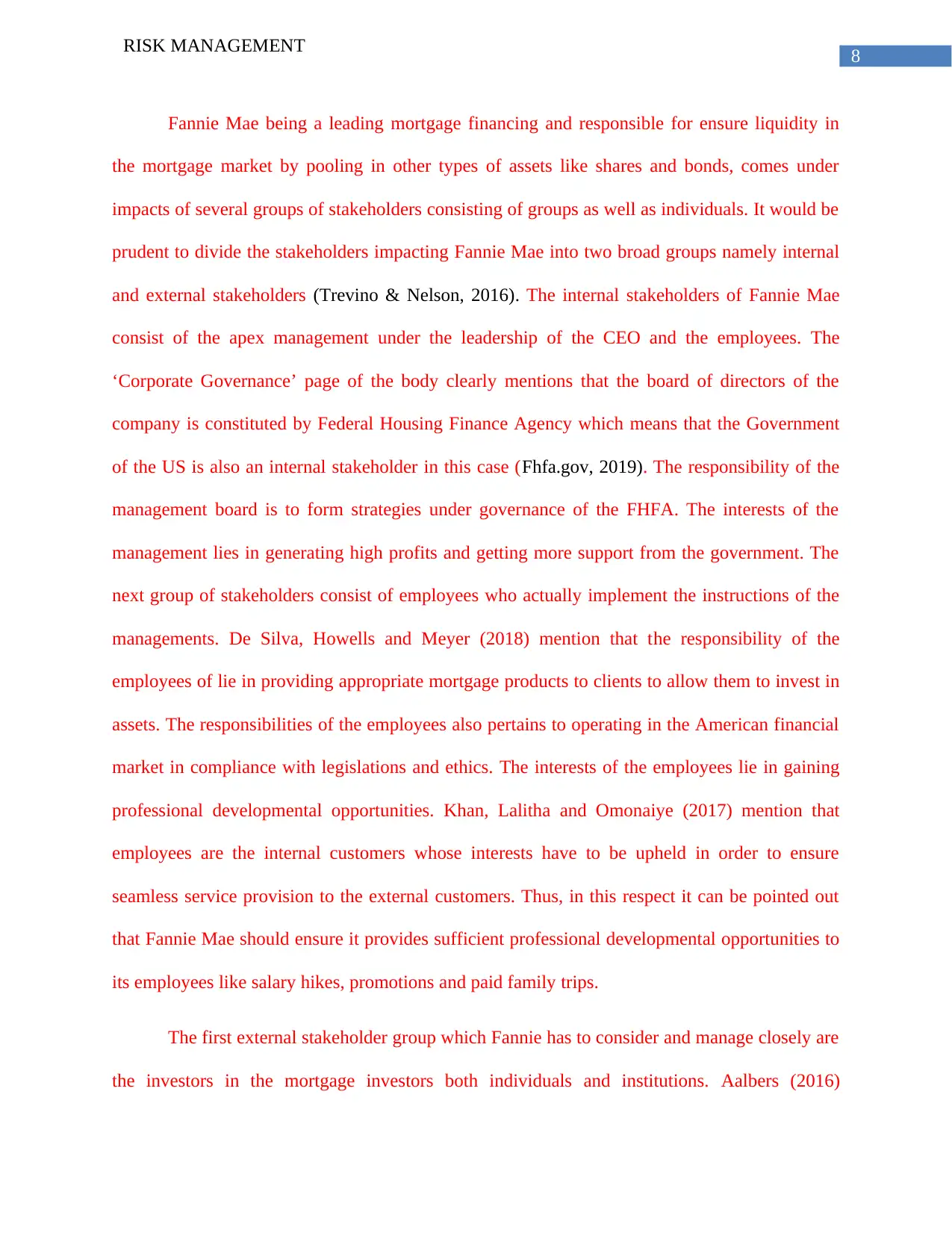
8
RISK MANAGEMENT
Fannie Mae being a leading mortgage financing and responsible for ensure liquidity in
the mortgage market by pooling in other types of assets like shares and bonds, comes under
impacts of several groups of stakeholders consisting of groups as well as individuals. It would be
prudent to divide the stakeholders impacting Fannie Mae into two broad groups namely internal
and external stakeholders (Trevino & Nelson, 2016). The internal stakeholders of Fannie Mae
consist of the apex management under the leadership of the CEO and the employees. The
‘Corporate Governance’ page of the body clearly mentions that the board of directors of the
company is constituted by Federal Housing Finance Agency which means that the Government
of the US is also an internal stakeholder in this case (Fhfa.gov, 2019). The responsibility of the
management board is to form strategies under governance of the FHFA. The interests of the
management lies in generating high profits and getting more support from the government. The
next group of stakeholders consist of employees who actually implement the instructions of the
managements. De Silva, Howells and Meyer (2018) mention that the responsibility of the
employees of lie in providing appropriate mortgage products to clients to allow them to invest in
assets. The responsibilities of the employees also pertains to operating in the American financial
market in compliance with legislations and ethics. The interests of the employees lie in gaining
professional developmental opportunities. Khan, Lalitha and Omonaiye (2017) mention that
employees are the internal customers whose interests have to be upheld in order to ensure
seamless service provision to the external customers. Thus, in this respect it can be pointed out
that Fannie Mae should ensure it provides sufficient professional developmental opportunities to
its employees like salary hikes, promotions and paid family trips.
The first external stakeholder group which Fannie has to consider and manage closely are
the investors in the mortgage investors both individuals and institutions. Aalbers (2016)
RISK MANAGEMENT
Fannie Mae being a leading mortgage financing and responsible for ensure liquidity in
the mortgage market by pooling in other types of assets like shares and bonds, comes under
impacts of several groups of stakeholders consisting of groups as well as individuals. It would be
prudent to divide the stakeholders impacting Fannie Mae into two broad groups namely internal
and external stakeholders (Trevino & Nelson, 2016). The internal stakeholders of Fannie Mae
consist of the apex management under the leadership of the CEO and the employees. The
‘Corporate Governance’ page of the body clearly mentions that the board of directors of the
company is constituted by Federal Housing Finance Agency which means that the Government
of the US is also an internal stakeholder in this case (Fhfa.gov, 2019). The responsibility of the
management board is to form strategies under governance of the FHFA. The interests of the
management lies in generating high profits and getting more support from the government. The
next group of stakeholders consist of employees who actually implement the instructions of the
managements. De Silva, Howells and Meyer (2018) mention that the responsibility of the
employees of lie in providing appropriate mortgage products to clients to allow them to invest in
assets. The responsibilities of the employees also pertains to operating in the American financial
market in compliance with legislations and ethics. The interests of the employees lie in gaining
professional developmental opportunities. Khan, Lalitha and Omonaiye (2017) mention that
employees are the internal customers whose interests have to be upheld in order to ensure
seamless service provision to the external customers. Thus, in this respect it can be pointed out
that Fannie Mae should ensure it provides sufficient professional developmental opportunities to
its employees like salary hikes, promotions and paid family trips.
The first external stakeholder group which Fannie has to consider and manage closely are
the investors in the mortgage investors both individuals and institutions. Aalbers (2016)
⊘ This is a preview!⊘
Do you want full access?
Subscribe today to unlock all pages.

Trusted by 1+ million students worldwide
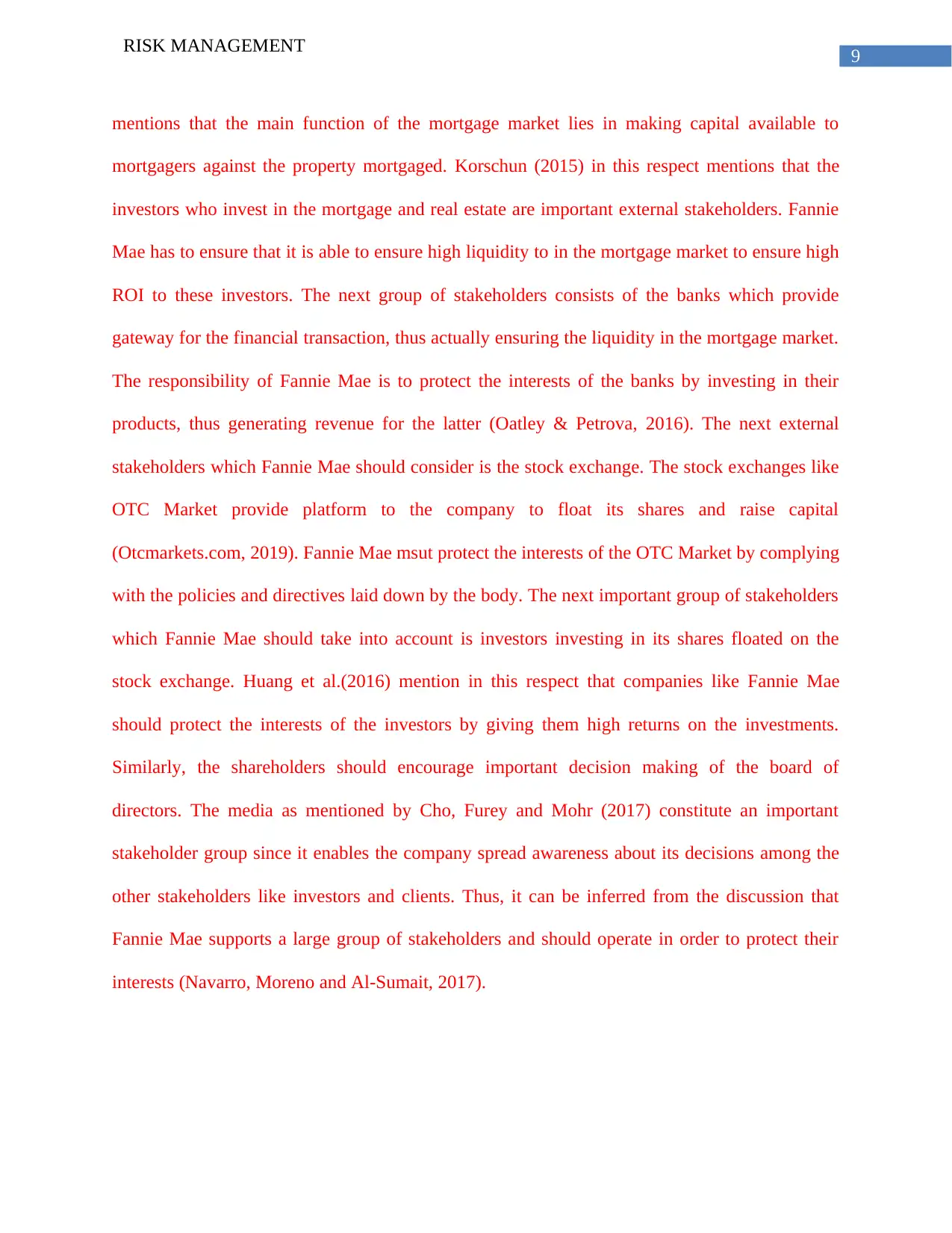
9
RISK MANAGEMENT
mentions that the main function of the mortgage market lies in making capital available to
mortgagers against the property mortgaged. Korschun (2015) in this respect mentions that the
investors who invest in the mortgage and real estate are important external stakeholders. Fannie
Mae has to ensure that it is able to ensure high liquidity to in the mortgage market to ensure high
ROI to these investors. The next group of stakeholders consists of the banks which provide
gateway for the financial transaction, thus actually ensuring the liquidity in the mortgage market.
The responsibility of Fannie Mae is to protect the interests of the banks by investing in their
products, thus generating revenue for the latter (Oatley & Petrova, 2016). The next external
stakeholders which Fannie Mae should consider is the stock exchange. The stock exchanges like
OTC Market provide platform to the company to float its shares and raise capital
(Otcmarkets.com, 2019). Fannie Mae msut protect the interests of the OTC Market by complying
with the policies and directives laid down by the body. The next important group of stakeholders
which Fannie Mae should take into account is investors investing in its shares floated on the
stock exchange. Huang et al.(2016) mention in this respect that companies like Fannie Mae
should protect the interests of the investors by giving them high returns on the investments.
Similarly, the shareholders should encourage important decision making of the board of
directors. The media as mentioned by Cho, Furey and Mohr (2017) constitute an important
stakeholder group since it enables the company spread awareness about its decisions among the
other stakeholders like investors and clients. Thus, it can be inferred from the discussion that
Fannie Mae supports a large group of stakeholders and should operate in order to protect their
interests (Navarro, Moreno and Al-Sumait, 2017).
RISK MANAGEMENT
mentions that the main function of the mortgage market lies in making capital available to
mortgagers against the property mortgaged. Korschun (2015) in this respect mentions that the
investors who invest in the mortgage and real estate are important external stakeholders. Fannie
Mae has to ensure that it is able to ensure high liquidity to in the mortgage market to ensure high
ROI to these investors. The next group of stakeholders consists of the banks which provide
gateway for the financial transaction, thus actually ensuring the liquidity in the mortgage market.
The responsibility of Fannie Mae is to protect the interests of the banks by investing in their
products, thus generating revenue for the latter (Oatley & Petrova, 2016). The next external
stakeholders which Fannie Mae should consider is the stock exchange. The stock exchanges like
OTC Market provide platform to the company to float its shares and raise capital
(Otcmarkets.com, 2019). Fannie Mae msut protect the interests of the OTC Market by complying
with the policies and directives laid down by the body. The next important group of stakeholders
which Fannie Mae should take into account is investors investing in its shares floated on the
stock exchange. Huang et al.(2016) mention in this respect that companies like Fannie Mae
should protect the interests of the investors by giving them high returns on the investments.
Similarly, the shareholders should encourage important decision making of the board of
directors. The media as mentioned by Cho, Furey and Mohr (2017) constitute an important
stakeholder group since it enables the company spread awareness about its decisions among the
other stakeholders like investors and clients. Thus, it can be inferred from the discussion that
Fannie Mae supports a large group of stakeholders and should operate in order to protect their
interests (Navarro, Moreno and Al-Sumait, 2017).
Paraphrase This Document
Need a fresh take? Get an instant paraphrase of this document with our AI Paraphraser
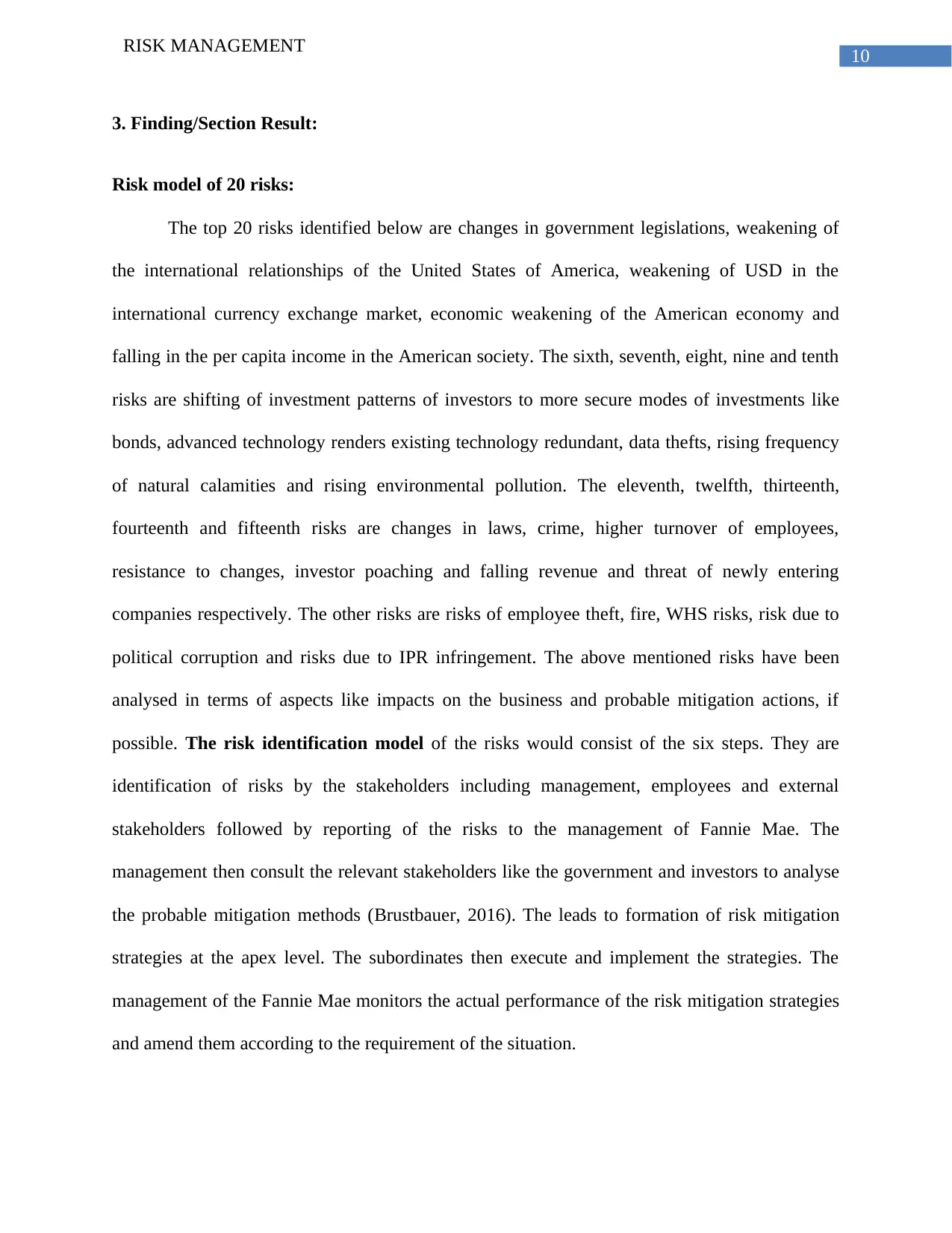
10
RISK MANAGEMENT
3. Finding/Section Result:
Risk model of 20 risks:
The top 20 risks identified below are changes in government legislations, weakening of
the international relationships of the United States of America, weakening of USD in the
international currency exchange market, economic weakening of the American economy and
falling in the per capita income in the American society. The sixth, seventh, eight, nine and tenth
risks are shifting of investment patterns of investors to more secure modes of investments like
bonds, advanced technology renders existing technology redundant, data thefts, rising frequency
of natural calamities and rising environmental pollution. The eleventh, twelfth, thirteenth,
fourteenth and fifteenth risks are changes in laws, crime, higher turnover of employees,
resistance to changes, investor poaching and falling revenue and threat of newly entering
companies respectively. The other risks are risks of employee theft, fire, WHS risks, risk due to
political corruption and risks due to IPR infringement. The above mentioned risks have been
analysed in terms of aspects like impacts on the business and probable mitigation actions, if
possible. The risk identification model of the risks would consist of the six steps. They are
identification of risks by the stakeholders including management, employees and external
stakeholders followed by reporting of the risks to the management of Fannie Mae. The
management then consult the relevant stakeholders like the government and investors to analyse
the probable mitigation methods (Brustbauer, 2016). The leads to formation of risk mitigation
strategies at the apex level. The subordinates then execute and implement the strategies. The
management of the Fannie Mae monitors the actual performance of the risk mitigation strategies
and amend them according to the requirement of the situation.
RISK MANAGEMENT
3. Finding/Section Result:
Risk model of 20 risks:
The top 20 risks identified below are changes in government legislations, weakening of
the international relationships of the United States of America, weakening of USD in the
international currency exchange market, economic weakening of the American economy and
falling in the per capita income in the American society. The sixth, seventh, eight, nine and tenth
risks are shifting of investment patterns of investors to more secure modes of investments like
bonds, advanced technology renders existing technology redundant, data thefts, rising frequency
of natural calamities and rising environmental pollution. The eleventh, twelfth, thirteenth,
fourteenth and fifteenth risks are changes in laws, crime, higher turnover of employees,
resistance to changes, investor poaching and falling revenue and threat of newly entering
companies respectively. The other risks are risks of employee theft, fire, WHS risks, risk due to
political corruption and risks due to IPR infringement. The above mentioned risks have been
analysed in terms of aspects like impacts on the business and probable mitigation actions, if
possible. The risk identification model of the risks would consist of the six steps. They are
identification of risks by the stakeholders including management, employees and external
stakeholders followed by reporting of the risks to the management of Fannie Mae. The
management then consult the relevant stakeholders like the government and investors to analyse
the probable mitigation methods (Brustbauer, 2016). The leads to formation of risk mitigation
strategies at the apex level. The subordinates then execute and implement the strategies. The
management of the Fannie Mae monitors the actual performance of the risk mitigation strategies
and amend them according to the requirement of the situation.
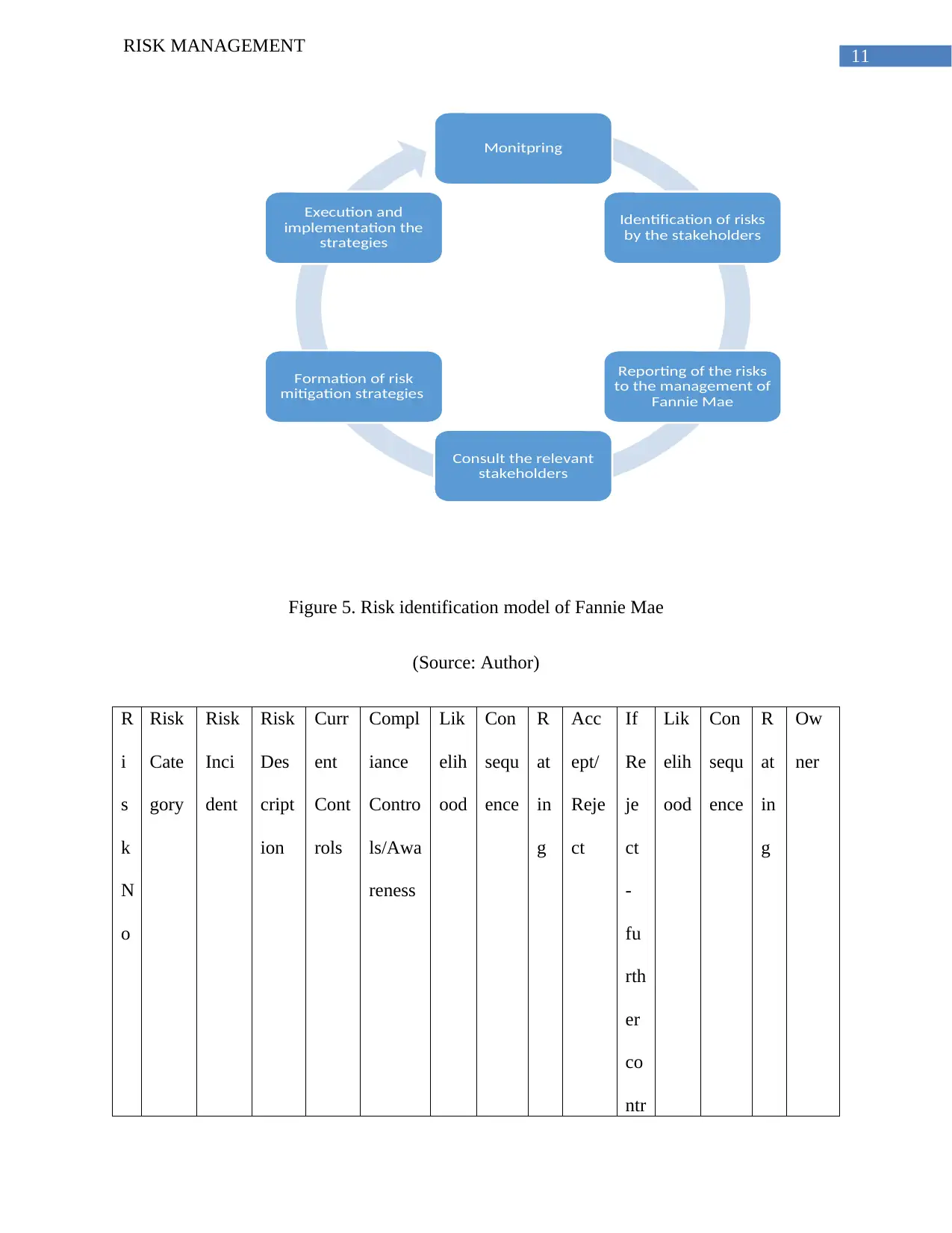
11
RISK MANAGEMENT
Figure 5. Risk identification model of Fannie Mae
(Source: Author)
R
i
s
k
N
o
Risk
Cate
gory
Risk
Inci
dent
Risk
Des
cript
ion
Curr
ent
Cont
rols
Compl
iance
Contro
ls/Awa
reness
Lik
elih
ood
Con
sequ
ence
R
at
in
g
Acc
ept/
Reje
ct
If
Re
je
ct
-
fu
rth
er
co
ntr
Lik
elih
ood
Con
sequ
ence
R
at
in
g
Ow
ner
Monitpring
Identification of risks
by the stakeholders
Reporting of the risks
to the management of
Fannie Mae
Consult the relevant
stakeholders
Formation of risk
mitigation strategies
Execution and
implementation the
strategies
RISK MANAGEMENT
Figure 5. Risk identification model of Fannie Mae
(Source: Author)
R
i
s
k
N
o
Risk
Cate
gory
Risk
Inci
dent
Risk
Des
cript
ion
Curr
ent
Cont
rols
Compl
iance
Contro
ls/Awa
reness
Lik
elih
ood
Con
sequ
ence
R
at
in
g
Acc
ept/
Reje
ct
If
Re
je
ct
-
fu
rth
er
co
ntr
Lik
elih
ood
Con
sequ
ence
R
at
in
g
Ow
ner
Monitpring
Identification of risks
by the stakeholders
Reporting of the risks
to the management of
Fannie Mae
Consult the relevant
stakeholders
Formation of risk
mitigation strategies
Execution and
implementation the
strategies
⊘ This is a preview!⊘
Do you want full access?
Subscribe today to unlock all pages.

Trusted by 1+ million students worldwide
1 out of 37
Related Documents
Your All-in-One AI-Powered Toolkit for Academic Success.
+13062052269
info@desklib.com
Available 24*7 on WhatsApp / Email
![[object Object]](/_next/static/media/star-bottom.7253800d.svg)
Unlock your academic potential
Copyright © 2020–2025 A2Z Services. All Rights Reserved. Developed and managed by ZUCOL.





